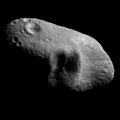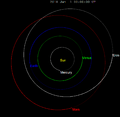433 Eros facts for kids

This picture of Eros shows the view looking from one end of the asteroid across the gouge on its underside and toward the opposite end.
|
|
| Discovery | |
|---|---|
| Discovered by | Carl Gustav Witt |
| Discovery date | August 13, 1898 |
| Designations | |
| 1898 DQ; 1956 PC | |
| Amor, Mars-crosser asteroid |
|
| Orbital characteristics | |
| Epoch October 22, 2004 (JD 2453300.5) | |
| Aphelion | 266.762 Gm (1.783 AU) |
| Perihelion | 169.548 Gm (1.133 AU) |
| 218.155 Gm (1.458 AU) | |
| Eccentricity | 0.223 |
| 643.219 d (1.76 a) | |
|
Average orbital speed
|
24.36 km/s |
| 320.215° | |
| Inclination | 10.829° |
| 304.401° | |
| 178.664° | |
| Physical characteristics | |
| Dimensions | 13×13×33 km |
| Mass | 7.2×1015 kg |
|
Mean density
|
2.4 g/cm³ |
| 0.0059 m/s² | |
| 0.0103 km/s | |
| 0.2194 d (5 h 16 min) | |
| Albedo | 0.16 |
| Temperature | ~227 K |
|
Spectral type
|
S |
| +7.1 to +15 | |
| 11.16 | |
433 Eros is a famous Near-Earth asteroid (NEA). It was the very first NEA ever discovered! This space rock is named after Eros, the Greek god of love.
Eros is an S-type asteroid, which means it's made mostly of stony materials. It's shaped a bit like a peanut, measuring about 13 by 13 by 33 kilometers. This makes it the second-largest near-Earth asteroid, after 1036 Ganymed.
Eros belongs to a group of asteroids called the Amors. It was also the first asteroid known to cross inside the orbit of Mars. Eros is one of the few NEAs that are bigger than 10 kilometers across. Scientists think it's even larger than the asteroid that created the Chicxulub crater in Mexico. That ancient impact probably led to the extinction of the dinosaurs.
On January 31, 2012, Eros came quite close to Earth. It was about 16.6 million miles (0.1787 astronomical units) away. To give you an idea, that's about 700 times farther than the Moon is from Earth.
Eros can sometimes get very bright in the sky. Every 81 years, it reaches a special position called "opposition." During these times, like in 1975 and 2056, Eros can be seen shining as bright as a +7.1 visual magnitude. This is brighter than Neptune and most other asteroids in the main asteroid belt.
Exploring Eros
Eros has been visited by a robotic spacecraft! The NEAR Shoemaker probe orbited the asteroid for a long time. It took many detailed pictures of Eros's surface.
At the very end of its mission, on February 12, 2001, NEAR Shoemaker made history. It gently landed on the asteroid's surface using its small engines. This was the first time a spacecraft had ever landed on an asteroid.
Scientists believe that asteroids like Eros don't stay in their orbits forever. Their paths can change over millions of years because of the pull of gravity from planets. Some studies suggest that Eros might even cross Earth's orbit within about 2 million years.
What is Eros Like?
Eros is not perfectly round like a planet; it's shaped more like a stretched potato or a shoe. Because of its irregular shape, the gravity on its surface changes a lot depending on where you are.
The temperature on Eros also changes a lot. During the day, it can get as hot as 100 degrees Celsius (212 degrees Fahrenheit). But at night, it drops to a very cold -150 degrees Celsius (-238 degrees Fahrenheit).
Eros is quite dense, with a density of 2,400 kilograms per cubic meter. This is similar to the density of Earth's rocky crust. A day on Eros lasts about 5.27 hours.
Scientists studying images from the NEAR spacecraft made an interesting discovery. Most of the large rocks scattered across Eros's surface seem to have come from one giant crater. This crater was likely formed about 1 billion years ago when another space rock crashed into Eros. This huge impact might also explain why almost half of Eros's surface doesn't have many small craters. It's thought that the dust and rocks thrown out by the collision filled in these smaller craters.
How Eros Was Found
Eros was discovered on the same night, August 13, 1898, by two different astronomers. Carl Gustav Witt found it in Berlin, Germany, and Auguste Charlois found it in Nice, France. Witt was actually taking pictures of another asteroid when he spotted Eros.
In 1975, Eros made history again when it became the first asteroid to be detected using radar. This technology uses radio waves to map objects in space.
As mentioned before, Eros was one of the first asteroids to be visited by a spacecraft. The NASA spacecraft NEAR Shoemaker began orbiting Eros in 2000 and landed on its surface in 2001.
Images for kids
-
Regolith of Eros, seen during NEAR's descent; area shown is about 12 meters (40 feet) across
See also
 In Spanish: (433) Eros para niños
In Spanish: (433) Eros para niños















